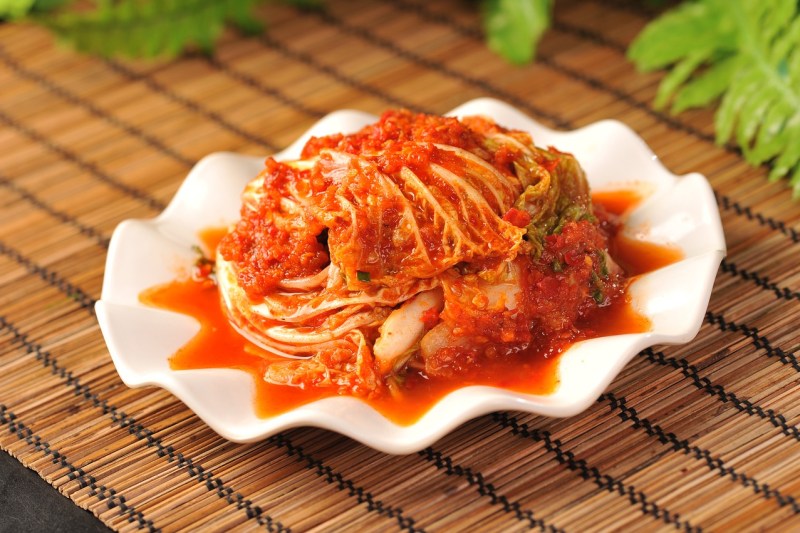
Korean cuisine is dynamic, an awesome combination of spice and umami. A small country historically overshadowed by its larger neighbors, China and Japan, the popularity of Korean cuisine has exploded in recent years, the result of South Korea’s incredibly popular music and entertainment. There has never been a more exciting time to explore Korean cuisine.
Related Guides
The Staples of Korean Cuisine

Korean cuisine is all about bold, umami flavors. Many Korean culinary staples are deeply savory and earthy, such as doenjang (fermented soybean paste), a central ingredient to soups and Korean BBQ, and spicy gochujang (fermented chili paste), which appears in countless sauces and marinades. Fermentation is another critical element of Korean cuisine — both doenjang and gochujang are fermented.
Of course, the most iconic Korean food is kimchi, a spicy fermented cabbage flavored with red pepper, garlic, and fish sauce. Kimchi is a culinary staple of South Korea and most meals will feature a serving of the household spicy vegetable. Besides cabbage, other vegetables like radish or scallions are also made into kimchi. For Koreans, kimchi and other pickled foods act as a palate cleanser for heavy or fried foods. For instance, pizza in South Korea will often be accompanied by pickles and fried chicken will feature cubes of pickled radish.
Although wheat noodles and bread are popular in modern South Korea, the cuisine is primarily rice-based. Rice is eaten for most meals, including breakfast. Plenty of sweet snacks, such as injeolmi (a mochi-like rice cake) and sweet drinks like sikhye are made from rice.
For people looking to incorporate Korean ingredients into their culinary repertoire, Chef Chris Oh, a Korean American chef with appearances on Food Network, NBC, Bravo, and Vice, Korean Chef Oh has some great tips. “Definitely put kimchi in everything! It is amazingly versatile and goes well in literally anything from hot dogs to grilled cheeses,” said Chef Oh. “If you want to get fancy, you can even replace the artichoke in artichoke dips with kimchi. Try sam jang (fermented bean paste and fermented chili paste combined), perilla leaves, and dried squid dipped in mayo and soy sauce. Try them and you will not be disappointed. Trust me, I’m a professional Korean.”
Communal Eating

Like many Asian cultures, Korean cuisine places a strong focus on communal eating. A Korean meal will often feature plenty of small side dishes called banchan, which can range from kimchi to salads and seafood. These are meant to be eaten with rice and other larger dishes.
Many popular Korean meals will also be cooked table-side. This includes the famous Korean barbecue as well as large cauldrons of soups meant to be consumed boiling hot. An example of a popular table-side soup is budae-jjigae (army stew), a red stew containing instant ramen, kimchi, hot dogs, spam, and sliced American cheese. These decidedly non-Korean ingredients were the result of surplus ingredients from American military bases after the Korean War. Innovative Korean cooks adapted these American ingredients into a soup that satisfied the Korean palate.
Korean Cuisine Goes Global

In recent years, Korean cuisine has gained incredible popularity. According to Chef Oh, this growth is the result of South Korea’s rising soft power. “Personally, I think the rise in Korean food has a lot to do with the popularity of the Korean entertainment industry with the likes of K-Pop music and Korean TV dramas being such a global phenomenon,” said Chef Oh. “Social media has also played a huge role in promoting Korean food, especially Korean BBQ.”
Korean restaurants can now be found everywhere from Thailand to America. This popularity has also led to a growing industry of culinary tourism in South Korea. In 2016, six thousand workers from a Chinese company held a chimaek (Korean fried chicken and beer) party in Incheon as part of a group tour. Chimaek gained notoriety in China largely due to its appearance in various popular Korean tv dramas. For Chef Oh, this development is only the beginning. “Honestly, the future is now! Korean food is here to stay. The fact that I can get a jar of kimchi in Fayetteville, AK means we’ve definitely made it!”
Korean Street Toast

(By Chef Chris Oh)
Chef Chris Oh is the chef-owner of Hanjip Korean BBQ, Seoul Sausage Co, Escala, and The Korean Mkt, the winner of multiple TV competition shows, and regular appearances on Food Network, NBC, Bravo, and Vice. He is also an author and clothing designer. His goal is to bridge previously unrelated markets through new culinary traditions. He is also the founder of KPOP Foods, a sauce, and snack brand.
This Korean-style toast recipe is a very popular street food in Korea and delicious any time of the day.
Ingredients:
- 1 oz cabbage, thinly sliced
- 1 oz onion, thinly sliced
- 1 oz carrot, cut into long thin strips
- 2 eggs
- 1/2 tsp salt
- 1/4 tsp black pepper
- 5 tbsp room temperature butter
- 4 white sandwich bread slices
- 3 tsp sugar
- 2 sliced honey ham
- 2 sliced American cheese Ketchup (mix in some KPOP Sauce for an extra kick)
- KPOP Kimchi Mayo
Method:
- In a large bowl, add chopped cabbage, onion, carrot, eggs, green onion, salt, and pepper and mix them well. Spread butter on both sides of the bread.
- Heat a large skillet over medium heat. Once the skillet heats up, add 2 tbsp of butter and let it melt.
- Pour the egg mixture, trying to make the omelet a square shape. Cook until the bottom of the omelet is cooked (around 2 to 3 minutes).
- Cut the egg omelet into half with a spatula and flip it over. Cook for another 2 to 3 minutes or until fully cooked.
- When the omelet is cooked, remove the omelet from the skillet and add honey ham slices to the skillet. Remove from the skillet after the ham is nicely cooked.
- Now, toast buttered bread on both sides, about 2 minutes on each side, or until it’s golden brown on the skillet. Remove once done.
- On a warm buttered and toasted bread, sprinkle about 1/2 tsp sugar evenly.
- Place the egg omelet on the bread slice and sprinkle 1 tsp sugar on top. Place warm ham and cheese on top of the sugared omelet and drizzle KPOP Sauce and Kimchi Mayo right on top. Cover this stack with another slice of buttered and toasted bread. Repeat with the rest of the ingredients and enjoy!



